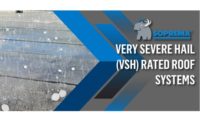New Research Leads Homeowners to Better Protection from Severe Weather

IBHS recreates hailstones found in nature and fires them at shingles to determine their impact resistance. Photo courtesy of IBHS.
The Insurance Institute for Business & Home Safety (IBHS) unveiled an optional hail upgrade to its rigorous FORTIFIED Home™–High Wind standard, a voluntary set of above-code design, building, and retrofitting steps to strengthen homes against severe weather. Now, in addition to helping homeowners guard against wind, FORTIFIED offers a solution to better protect against hailstorms too.
Combined, FORTIFIED Home–High Wind & Hail helps homeowners in parts of the country that face multiple threats achieve extra protection from severe thunderstorms that generate high wind, hail, and tornadoes. The result is a stronger roof shown in field and lab studies to reduce the risk of damage.
FORTIFIED Home–High Wind & Hail is based on the latest research conducted at IBHS’s state-of-the-art research center in Richburg, S.C. There, scientists recreate severe weather events with windspeeds reaching up to 130 mph and hailstorms using hailstones manufactured on-site, consistent with those that occur naturally, to understand and identify ways to reduce the damage they cause to residential properties. The hail supplement, now available to be paired with the existing high wind standard, is the result of a new impact shingle test method established by IBHS in 2019.
“Year after year, severe weather wreaks havoc on communities across the country’s heartland,” said Fred Malik, managing director of FORTIFIED programs at IBHS. “FORTIFIED Home–High Wind & Hail offers homeowners the best-known protection against the combination of weather threats common to this part of the country, providing families their best chance to return home immediately after a storm hits.”
The new hail supplement goes beyond typical impact resistance measurements and requires high-performing shingles that rank Excellent or Good in IBHS’s 2019 Hail Impact Standard Ratings. FORTIFIED Home–High Wind & Hail requires a roof covering that can withstand hail up to 2 inches in diameter. This gives homeowners added confidence their shingles have demonstrated they can perform under realistic testing scenarios, which mimic how real-world hail attacks a roof. For homeowners who regularly face hail, this can save both the hassle and expense of repeated shingle replacement.
“Not all shingles labeled as ‘impact-resistant’ perform equally. Existing standardized tests use outdated physics and are unable to replicate all the different kinds of damage we see on roofs,” says Dr. Tanya Brown-Giammanco, managing director of research at IBHS. “We’ve devoted years to better understanding the scientific characteristics of hail, replicating those characteristics in the lab, and analyzing how shingles perform against them to give consumers confidence when selecting an impact-resistant shingle.”
Roofs installed to the FORTIFIED Home–High Wind & Hail standard have multiple layers of defenses to prevent a cascade of damage that can start at the roof and impact the integrity of the entire structure during high winds. The beyond-code requirements include:
- Stronger connections to hold the roof onto the house
- Reinforced edges to help protect one of the roof’s most vulnerable areas from high winds
- A sealed roof deck to prevent rain from entering the home, even if shingles are lost
- High-performing impact resistant shingles that are superior performers based on IBHS’s innovative impact test
With this added protection, homes have shown to be durable in up to EF-2 level winds and against up to 2-inch hail.
“FORTIFIED is an effective and affordable option to combat winds up to EF-2 levels, and it’s important to note tornadoes rated as EF-4 or EF-5 have very small areas where the winds are that strong,” explains Brown-Giammanco, who is also a wind engineer and meteorologist. “In those storms, many of the homes actually face significantly lower wind speeds than those at the core. FORTIFIED can narrow the path of damage so building to this standard has the potential to bring peace of mind to homeowners routinely threatened by tornadoes and high winds.”
“A home is the largest investment most families will make, and every year they are threatened by severe weather like hail, high winds, and even tornadoes,” adds Malik. “For the extra investment when re-roofing, homeowners can benefit from the science behind FORTIFIED to avoid damage, possibly saving significantly more in repairs the next time storms strike. Oklahomans are among the first in the Great Plains and Midwest to have the added benefit of available mitigation credits on homeowner’s insurance policies, specifically for getting a FORTIFIED designation.”
IBHS is piloting FORTIFIED Home‒High Wind & Hail in Oklahoma City, in conjunction with Oklahoma-based Disaster Resilience Network, but the standard can be followed nationwide. Homeowners can find a FORTIFIED-trained roofer who specializes in resilient roofing at fortifiedhome.org/directory or by having the qualified roofer of their choice follow the building standards for FORTIFIED Home–High Wind & Hail.
To receive a FORTIFIED designation, which can qualify a home for insurance discounts in some states, including Oklahoma, homeowners must have their roofer, or a FORTIFIED evaluator, submit required documentation confirming the requirements have been met to IBHS.
Looking for a reprint of this article?
From high-res PDFs to custom plaques, order your copy today!




.png?height=200&t=1738612959&width=200)
.jpg?height=200&t=1695151971&width=200)
